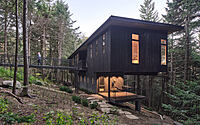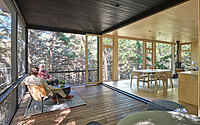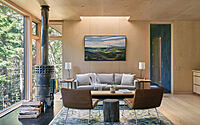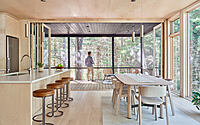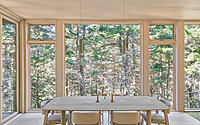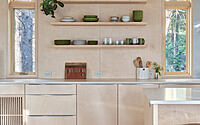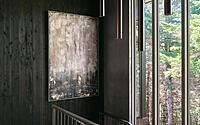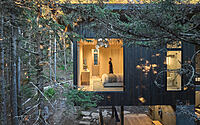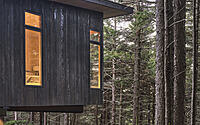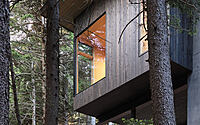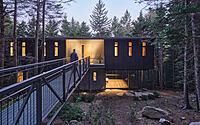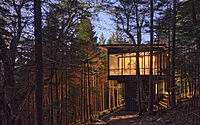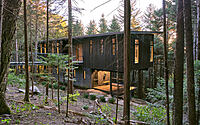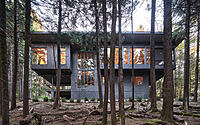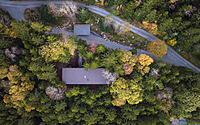Spruce Ridge Cabin: Eco-Luxury Hidden in a Red Spruce Forest
Welcome to the Spruce Ridge Cabin, a modern wooden haven nestled within the lush red spruce forest of Sylva, North Carolina. Designed by Altura Architects, this eco-conscious cabin strikes the perfect balance between luxury and sustainability.
The cabin’s design seamlessly integrates with the surrounding environment, featuring cedar siding and a dark pine tar stain to complement the forest hues. Inside, the warm birch interiors and unified wood tones create a cozy atmosphere, allowing nature to take center stage.
Discover this extraordinary retreat that promotes a meaningful connection with the land and its delicate ecosystem.













About Spruce Ridge Cabin
Embracing Nature in a Sustainable Cabin Design
Our client, an avid outdoorsman and environmentalist, approached us with a unique piece of land nestled within a red spruce forest on a mountain ridge at 5,700 feet (1,737 meters) elevation. The dense evergreen forest and high elevation forge a microclimate and habitat, fostering rare species of flora and fauna. We shared a vision for the cabin design, aiming to minimize the impact on this delicate ecosystem.
Harmoniously Integrating the Cabin with its Surroundings
We began the design concept by hiding the cabin within the forest as much as possible. We positioned the cabin downhill, away from the parking area, and preserved a 40-foot (12-meter) wide portion of the forest to screen the building. A pedestrian bridge crosses into the forest, offering a physical and emotional transition that further separates the cabin from civilization.
Exterior Palette Inspired by the Red Spruce Forest
The exterior palette mirrors the colors of the red spruce forest. We clad two cantilevered forms in cedar siding, using vertical lines throughout to reinforce the rhythm of the surrounding trees. A dark pine tar stain complements the tree bark’s tone, while we finished the base and central connector of the cabin with a cement plaster, tinted to blend with the granite rock outcroppings.
Creating a Warm and Inviting Interior Space
The dense evergreen forest can feel dark at times, so we wrapped the interior spaces in birch to create a warm and light ambiance. Unified wood tones in the cabinets, flooring, and furniture maintain a tranquil interior palette, despite the woodgrain’s motion, and allow the textures of the forest views to take center stage. A wall of folding doors opens the main living spaces to the screen porch to the south, reinforcing the cabin’s strong connection to the forest.
Building Responsibly with Expert Guidance
A crucial aspect of building responsibly on this fragile land involves collaborating with a team of experts. Equinox Environmental consultants devised a comprehensive site concept that minimizes the cabin’s impact on the land during construction and beyond. The strategy encompasses an integrated stormwater system, a reduced building footprint, tree and soil preservation, and a forest management plan.
Prioritizing Ecosystem Preservation in Every Decision
Each decision throughout our process prioritizes preserving the site’s existing ecosystems. The home offers a comfortable retreat that also supports a lifestyle and daily experiences, nurturing a meaningful relationship with the surrounding land.
Photography by Keith Isaacs Photo
Visit Altura Architects
- by Matt Watts